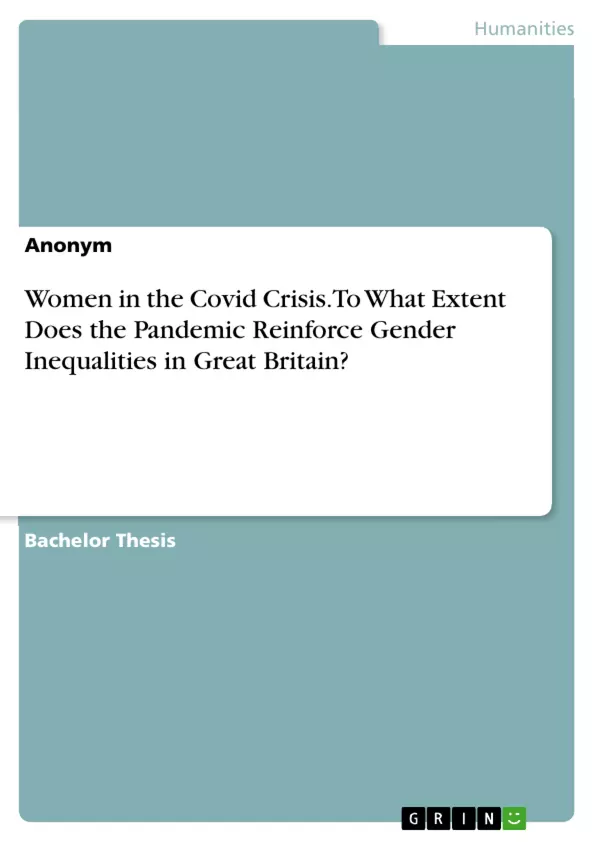The aim of this thesis is to examine the impact of the coronavirus pandemic on women in the UK. As a theoretical basis, I will first illustrate gender inequalities that already existed before the pandemic and divide them into the private and public sphere. Afterwards, the impact of the coronavirus crisis on women will be analysed by looking more closely at the effect on women in the workforce and the physical and mental implications. Next, I will introduce a survey that I conducted regarding women's representation in media coverage in the UK to present different perceptions regarding this matter. The paper continues by examining the distribution of men and women as experts on the pandemic. Finally, five coronavirus-related articles from the online tabloid DailyMail will be analysed to explore whether men are actually more likely to be used for objective statements and women for subjective opinions during the pandemic. My conclusion will summarise the above points and answer the question of this thesis: To what extent does the pandemic reinforce gender inequalities in Great Britain?
Just as any other country around the world, Great Britain was hit hard by the coronavirus crisis and is now suffering its consequences. At the present time, Great Britain has recorded around 166,000 deaths. The UK has implemented many measures to counteract the pandemic: in addition to the compulsory wearing of masks, this also involves the general shutdown of public life, the switch to online teaching, and the temporary closure of kindergartens. Besides the economic shock the country is suffering from, social disparities have become more visible.
There are many structural problems that the pandemic has clearly brought to light: Overwork and underpayment in the health sector, digitalisation that is progressing too slowly, and too little recognition of workers in social professions - these are just some examples. However, if you look at statistics, you quickly notice that in a lot of areas it is especially women, who have to suffer from the pandemic. According to the Office for National Statistics (ONS) of Great Britain "[w]omen were more likely to be furloughed, and to spend significantly less time working from home, and more time on unpaid household work and childcare".
Inhaltsverzeichnis (Table of Contents)
- Introduction
- Gender inequalities in Great Britain
- Gender inequalities in the private sphere
- Gender inequalities in the public sphere
- The impact of the coronavirus pandemic on women
- The impact of the coronavirus pandemic on women in the workforce
- The impact of the coronavirus pandemic on women's physical and mental well-being
- The male voice of the coronavirus pandemic
- Survey
- The lack of a female voices as experts during the pandemic
- Analysis of coronavirus related articles in the Daily Mail
Zielsetzung und Themenschwerpunkte (Objectives and Key Themes)
This thesis aims to investigate the impact of the coronavirus pandemic on women in the UK. It begins by establishing pre-existing gender inequalities in both the private and public spheres. The analysis then explores the pandemic's effects on women's workforce participation and their physical and mental well-being. Further, the study will examine the representation of women in media coverage related to the pandemic through a self-conducted survey and analysis of articles from the Daily Mail.
- Pre-existing gender inequalities in Great Britain
- The impact of the COVID-19 pandemic on women's employment
- The pandemic's effect on women's physical and mental health
- Gender representation in media coverage of the pandemic
- The disproportionate impact of the pandemic on women
Zusammenfassung der Kapitel (Chapter Summaries)
Chapter 1: Introduction: This chapter sets the scene, outlining the devastating impact of the coronavirus crisis in Great Britain and highlighting the disproportionate effect on women. It introduces the thesis's objective to examine this impact.
Chapter 2: Gender inequalities in Great Britain: This chapter lays the groundwork by exploring pre-existing gender inequalities in the UK, dividing them into private and public spheres. It sets the stage for understanding how the pandemic may have exacerbated these existing imbalances.
Chapter 2.1 Gender inequalities in the private sphere: This section delves into how gender ideology structures households and the emergence of traditional family structures, drawing upon Simone de Beauvoir's "The Second Sex" and a study on male-only households to illustrate the unequal distribution of domestic labor.
Chapter 3: The impact of the coronavirus pandemic on women: This chapter analyzes the pandemic's effects on women, specifically focusing on its impact on their employment and their physical and mental well-being.
- Arbeit zitieren
- Anonym (Autor:in), 2022, Women in the Covid Crisis. To What Extent Does the Pandemic Reinforce Gender Inequalities in Great Britain?, München, GRIN Verlag, https://www.grin.com/document/1515263



